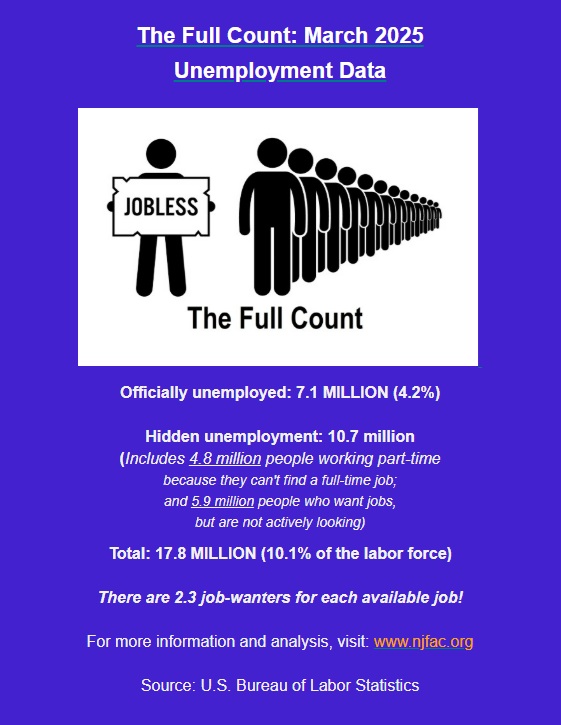
By Frank Stricker
April 13, 2025
For the most part, the latest job numbers were more of the same. The official unemployment rate at 4.2% was in the 4.0% – 4.2% range where it has been for a year.
As we see in the Full Count, the unemployment rate for whites was 3.7%, and for blacks, 6.2%. The rate for disabled workers was high at 7.8% and it always is high. So is the rate for teens (ages 16 through 19). They had an unemployment rate of 13.7%. Black teens had, as usual, an even higher rate of unemployment at 20.8%.
Also seen in the Full Count, the National Jobs for All Network’s real unemployment rate was 10.1%, more than twice the official rate. The BLS has its own amplified unemployment rate that includes, among other groups, non-searching discouraged workers. That unemployment rate was 7.9%–higher than the official rate but much lower than NJFAN’s unemployment estimate. In either case, there is plenty of hidden unemployment out there. There are many people who want to work and are not searching in the right way to be counted as unemployed.
If, for a moment, we ignore the Administration’s assault on good jobs and also the two amplified unemployment counts, the employment report looks pretty good. The official rate does not yet show much of the impact of the President’s wild tariff policies nor his slash-and-burn layoffs of Federal workers. (The March numbers were gathered around the second week of the month.) Total jobs from the Establishment survey of non-farm employers increased by 228,000. That was higher than expected and higher than the average for recent months. There were gains in every major sector except one: Federal jobs. Those were down 4,000 in March, and they fell in February by 11,000. I think these last numbers are just the early returns on the Trump-and-Musk assault on Federal workers.
The Establishment numbers on total jobs may catch up with reality in the next report, which will cover the news for April. According to Elena Shao and Ashley Wu in The New York Times (April 8, 2025, “Federal Work Force Cuts So Far”), the number of Federal employees who took buyouts was about 75,000. Other thousands were just laid off. Looking ahead, Shao and Wu predict that the Federal work force could be reduced by 300,000 people when the cutters are finished. Do I need to comment on the damage that will do to government programs–in particular, to those whose clients need special attention? And imagine the situations of hundreds of thousands of people who are losing good jobs. More goods jobs is not something the current Administration really cares about. Government leaders ought to be focusing on direct, good-job creation rather than good-job destruction. We have too few jobs and far too many lousy ones. Talk about returning factory jobs is pie-in-the sky right now and perhaps forever.
Next month the statistics will catch up with the bad news and there will be more of it. The rate of job openings is pretty low and will probably decline. Also, as a rule, high worker-quit rates suggest that workers are confident about finding new jobs. As of February, the quit-rates were not particularly high, and I think they will decline. Surveys of consumer sentiment and other evidence suggest that people are starting to worry about keeping their jobs. Trump’s attack on Federal jobs and the violent teeter-totter of his tariff programs do not promote confidence. In a University of Michigan survey, 2/3 of the respondents thought that unemployment would rise. Something called the US Economic Policy Uncertainty Index is higher than it was during the pandemic. Meanwhile, Guy Berger, director of economic research at the Burning Glass Institute—no joke—seems pretty optimistic, but he’s also on-the-other-handing it. He finds nothing to suggest that “we’ve fallen into this doom loop” of a downturn where things are going to get worse, but he guesses that there will be “an incremental worsening.” Whoopee! I was worried there for a minute. (Special information in this paragraph is from Emily Stewart, “Hold on to Your Desk,” Business Insider, March 30, 2025.)
Jokes aside, the state of the whole economy is something to worry about. If Trump keeps messing with trade and tariffs, if his government disemploys hundreds of thousands of government employees, and if he and his party clamp down on programs that subsidize millions of poor and working-class people who spend most of their incomes, while Republicans give huge money handouts to the billionaires and trillionaires who cannot possibly spend most of their income on consumption goods that drive job growth, they will cause a recession. And they—Trump especially–don’t seem to be worried about that possibility.
Frank Stricker is on the board of the National Jobs for All Network and writes for NJFAN and Dollars and Sense. In 2020 he published a book called American Unemployment: Past, Present, and Future (2020). He taught History and Labor Studies at California State University, Dominguez Hills, for 37 years.

